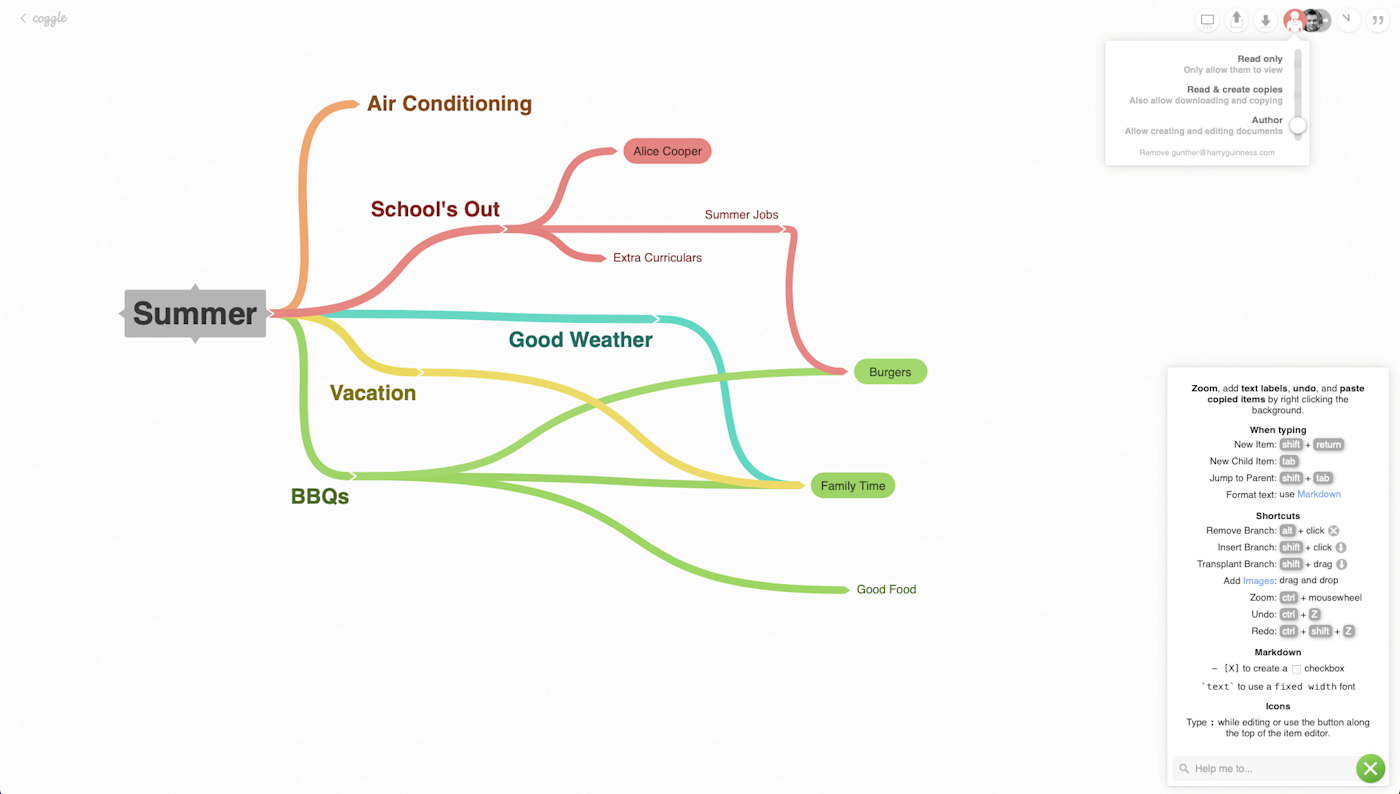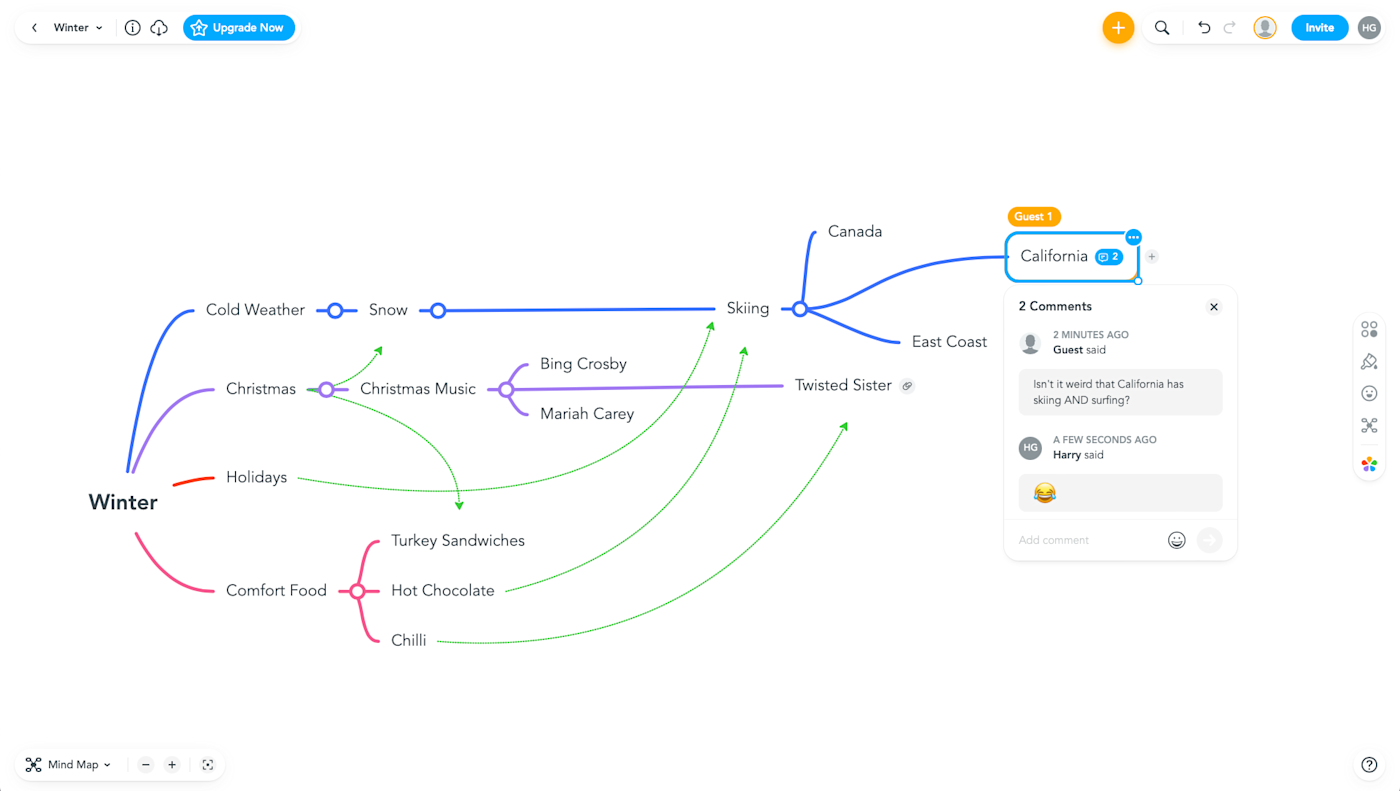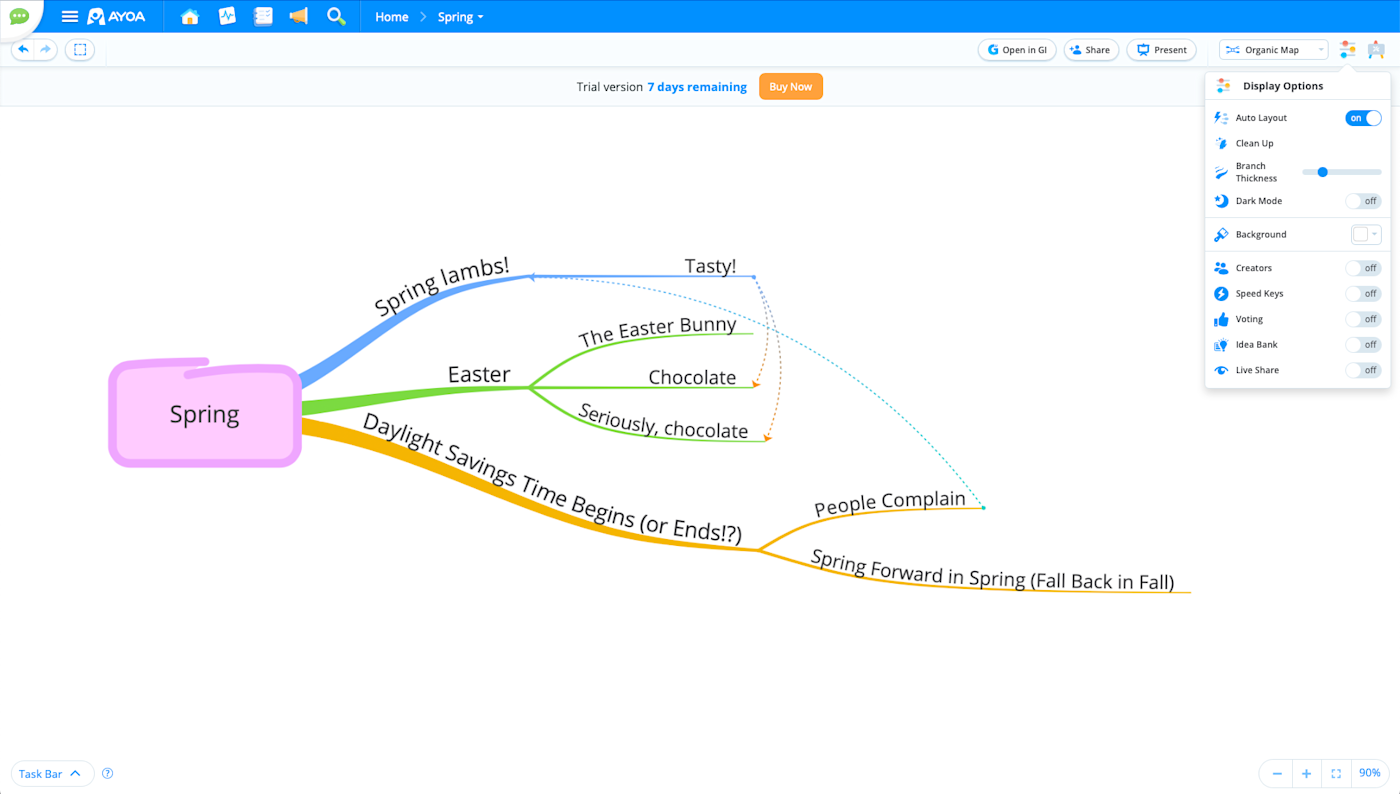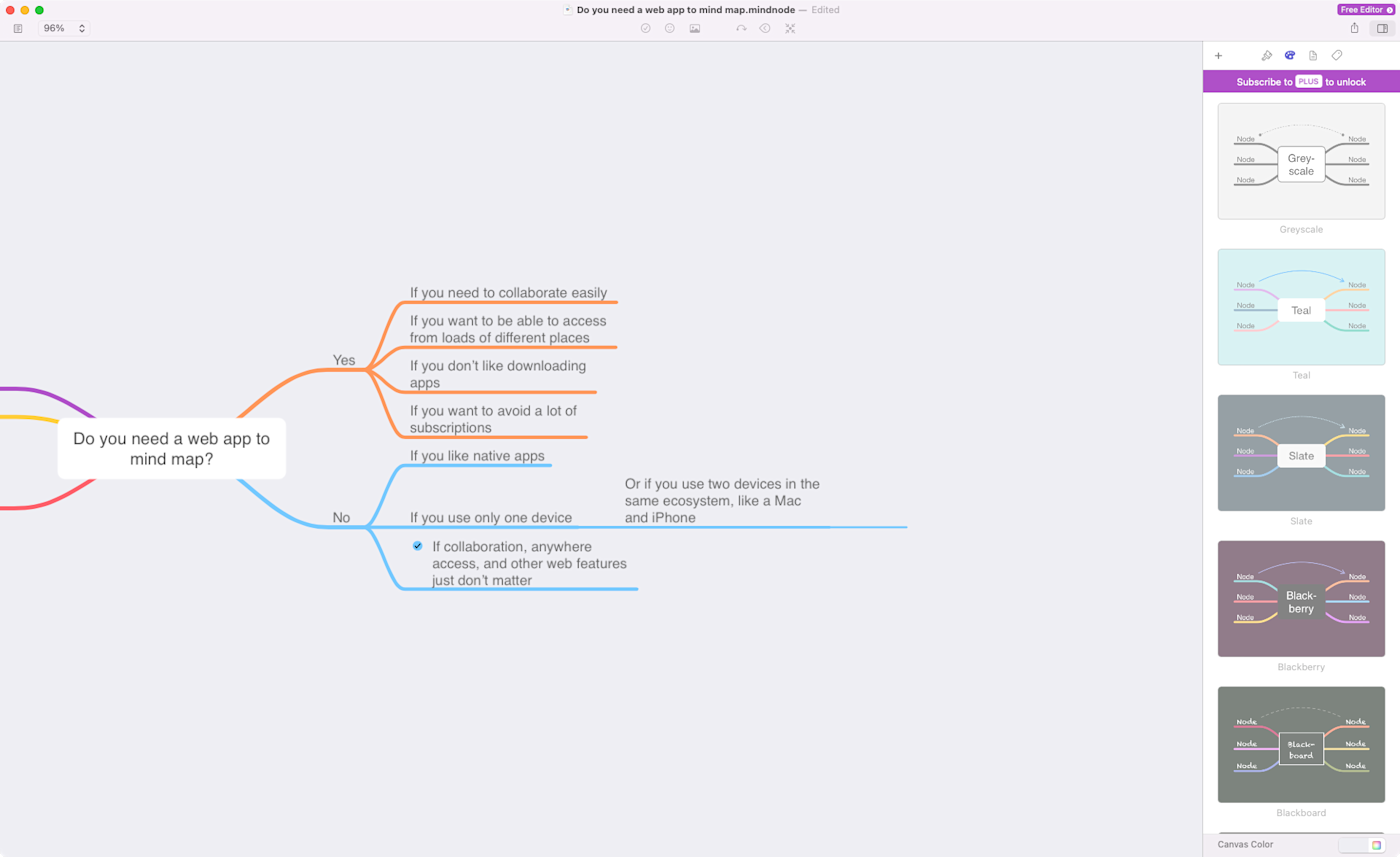The best mind mapping software in 2022 | Zapier
Mind mapping is a creative way to brainstorm and find connections between different ideas. Done right, it’s a great way to come up with new ideas and solutions to tricky problems, outline an article or presentation, and generally just get your thoughts in order.
Use automation to support brainstorming, delegation, and communication
I do most of my mind mapping digitally—and even when I don’t, I often recreate a paper mind map online so that I can have it safely stored and easily searched. (It’s a weird hybrid approach, but it works for me.)
Over the past several years of updating this list, I’ve tested close to 50 different mind map tools, many multiple times as they’ve been updated and added new features. I’ve also made dozens of mind maps myself, both on paper and digitally. Pen and paper set a very high bar to clear, but these are the five best mind mapping apps that manage to clear it.
Mục lục bài viết
The 5 best mind mapping tools in 2022
-
Coggle for mind map beginners and occasional use
-
MindMeister for collaborating on a mind map with a team
-
Ayoa for a modern approach to mind mapping
-
MindNode for Apple users
-
XMind 2022 for personal brainstorming
What is mind mapping?
Traditionally, a mind map is done with a pen (or, ideally, loads of colored pens) and paper. You start by writing a central idea or theme in the middle of a blank sheet of paper. Then the fun starts: around your central theme, you create “nodes” connected by lines, each with its own related idea or theme. For example, if the central theme was “Summer” (say, for a marketing campaign), the first five or so nodes might be “Good weather,” “BBQs,” “Vacation,” “Air conditioning,” and “School’s out.”
From each node, you then repeat the process, drilling deeper into the different concepts. “BBQs” might lead to “Family time,” “Good food,” and “Burgers.” “School’s out” could lead to “Summer jobs,” “Extracurriculars,” and “Alice Cooper.”
Some ideas will also connect back to other ideas. “Family time” could also link to “Good weather” and “Vacation.” “Burgers” could link to “Summer jobs.” But by getting all these branching concepts down on paper, you can start to see the relationships between different things and generate new ideas. Who’d have thought before we started brainstorming that Alice Cooper flipping burgers at a family BBQ (or maybe in a fast food joint?) could make for a killer summer ad?
What makes for great mind map software?
How we evaluate and test apps
All of our best apps roundups are written by humans who’ve spent much of their careers using, testing, and writing about software. We spend dozens of hours researching and testing apps, using each app as it’s intended to be used and evaluating it against the criteria we set for the category. We’re never paid for placement in our articles from any app or for links to any site—we value the trust readers put in us to offer authentic evaluations of the categories and apps we review. For more details on our process, read the full rundown of how we select apps to feature on the Zapier blog.
Mind mapping with a sheet of paper and a pen is an incredibly intuitive and natural way to work. You just start drawing and go from there with almost nothing in your way.
It does have its downsides, though. Unless you have a gigantic whiteboard knocking around, you’re limited to a fairly small piece of paper. It’s not searchable, and you can’t easily undo things or make edits. And, worst of all, if you lose your mind map, you don’t have a backup. So even though pen-and-paper mind mapping is delightful, it might be worth considering a mind map app.
While each mind mapping tool on this list has its own unique benefits, they all meet at least the following criteria:
-
It’s actually a mind mapping app. A lot of drawing, diagramming, and flowchart apps are marketed as mind map apps—but they aren’t. While you could make a mind map in them, you could also use PowerPoint, Photoshop, or MS Paint. You could even get a key and carve a mind map into your computer screen. Just because something can be used to make a mind map, doesn’t mean it should or that it will do it well. These more general-purpose apps tend to lack the features that make creating a mind map digitally as easy as possible, like automatically linking nodes, brainstorming modes that let you get a lot of concepts down quickly, and search. For an app to make this list, we dug past the marketing and made sure it was designed from the ground up for brainstorming, not for drawing or creating professional diagrams or charts.
-
It gets out of the way. Mind mapping with a pen and paper is a joy. No app is ever going to be quite as intuitive, but it should come as close as possible. After a short learning period to get up to speed, you shouldn’t have to stop and think to create a node, or dig through menus to connect two ideas. The app should just fade into the background—the same way your web browser does.
-
It offers an unlimited canvas. A digital mind map tool should have a practically unlimited canvas size, so you can make a mind map as big as you can conceive of, connecting huge numbers of ideas if you want. Using an app is all about overcoming the analog downsides, not reinforcing them.
-
It allows you to attach files. Sometimes you need more than a few words to fully illustrate a concept—and doodling is a big part of analog mind mapping. For an app to make this list, you need to be able to attach images, videos, documents, web pages, and other assorted extras to your mind maps.
-
It allows you to save and export. You can’t easily edit, save, or share your paper mind maps, so one of the big reasons to go digital is that you can. The best mind map software lets you come back to a mind map later and change it up, save it, and export it in different formats, so you can send it to your colleagues, classmates, or anyone else.
This is my third year keeping this list updated, so I’m very familiar with all our top picks—plus all the apps that come close to breaking into this list but just fall short. To test each mind map app, I use it. I start with some silly concept and just mind map away to see how it works and feels. (I’m always comparing things back to both paper and the other apps.) If it’s nice to use and ticks all the boxes, it goes on a shortlist to be considered for inclusion. If it’s awkward, gets in the way, or doesn’t have a key feature, I leave it off the list (though all the testing notes get added to an increasingly complex spreadsheet, so I can check if things improve next year). From that shortlist, I pull out the best of the best. So, here are the five best mind mapping apps.
Best mind mapping software for beginners and occasional use
Coggle (Web)

Coggle is, in many ways, the mind map maker to beat. It’s fast, intuitive, and easy to use (with great keyboard shortcuts)—even though it’s only available through your web browser. Perhaps best of all, Coggle is free for up to three private mind maps. As long as you save your mind maps as PDFs, plain text documents, or images, you can delete your old drafts and basically have unlimited free mind mapping. If you’re only looking to use a digital option every few months, it’s practically perfect.
The moment you start a diagram in Coggle, you’ll see the central node of a new mind map. From there, you can create new nodes by clicking on the plus sign or—if you want a faster experience—tapping the tab key. There’s a handy cheatsheet of all the keyboard shortcuts in the bottom-right corner of the app, and it’s worth learning to use them.
Coggle is packed with thoughtful touches. One of my favorite features is that you can format your mind map items and messages with Markdown, so you can get as fancy as you need to while adding your text, images, and links to the canvas. There’s also collaboration built in. If you want to bounce some ideas off a colleague, you can go ahead and add them to your mind map, carry on a conversation in the messages sidebar, or go into full-screen presentation mode to take a step back and do more high-level ideation.
In short, for occasional mind mapping (whether on your own or with colleagues), Coggle nails it, and it’s your best option s for free mind mapping software. Its paid offering is also great, but for $60/year, you can get other mind mapping apps that work natively rather than just through a web browser.
Coggle pricing: Free for up to three private diagrams; $5/month for unlimited private diagrams and extra mind mapping tools (like additional shapes and color control).
Best mind mapping software for collaborating with a team
MindMeister (Web, iOS, Android)

MindMeister is one of the best collaborative mind mapping tools out there. It’s a little less intuitive to use than Coggle, and some features—like exporting your mind maps as a PDF or image, or attaching images and videos—are limited to paid plans, so it’s a less enticing option for solo mind mappers. For teams, though, its collaboration features are great: you can add team members and guests to your mind map, leave comments for each other, and otherwise work together to brainstorm or present ideas.
It also has a sleek modern interface and plenty of customization options (including some more corporate layouts). Plus, it automatically aligns your nodes, which makes it easy to create great-looking mind maps that won’t look out of place in a meeting room.
MindMeister is owned by the same people that make MeisterTask, a web-based, kanban-style project management app. The two tools are integrated, so you can turn your brainstorm session into an actionable project, assigning individual items on a mind map to members of your team, tracking task progress, and syncing it all with your other project boards inside MeisterTask—which even integrates with Zapier.
For an in-depth look at what a sample MindMeister/MeisterTask project might look like, take a look at our article about how to jumpstart new projects with mind maps.
MindMeister pricing: Free for the Basic plan that includes up to three mind maps and real-time collaboration. From $4.99/month for the Personal plan that includes unlimited mind maps, file attachments, and PDF exports.
Best mind mapping software for a modern mind mapping approach
Ayoa (Web, iOS, Android, macOS, Windows)

Ayoa is the follow-up to one of our previous mind mapping picks, iMindMap. It was created by Chris Griffiths, a mind mapping expert and author who has collaborated with Tony Buzan, the man responsible for popularizing mind mapping in the 1970s. Put simply, it’s got a serious mind mapping pedigree—and it shows.
Open Ayoa, create a Mind Map, and you have a choice of making an Organic Map, a Speed Map, a Radial Map, or a Capture Map—though you can also change between them at any time with a dropdown menu. (You can also make a Whiteboard or Task Board if you’re doing some more corporate-style brainstorming, though these features are limited to the more expensive plans.)
-
The Organic Map is the most traditional and mimics the kind of thing you’d draw with a pen and paper. You aren’t confined to just putting words in boxes. Instead, you’re encouraged to label the swooshing, Sharpie-like branches that connect different ideas. It’s a much more natural process than a lot of the other apps.
-
A Speed Map is similar, but with a stripped-down setup designed for rapid brainstorming. You’re almost forced to use keyboard shortcuts, like
Tabfor a new child branch andEnterfor a new sibling branch, as the buttons to do the same are hidden away unless you deliberately click on a node. It’s great when you want to ideate quickly. -
A Radial Map is a totally modern approach to mind mapping. Instead of nodes and lines, every idea becomes part of a series of concentric circles. A peripheral segment of your central idea becomes the center of its own circle of ideas as you move outward. It’s mind mapping that’s moving beyond the limits of what can even be imagined with paper.
-
A Capture Map is a blank canvas that allows you to quickly add ideas, whether they’re related or not. They float around the page as little thought bubbles. You can then connect them and turn your rough outline into an Organic Map, Speed Map, or Radial Map.
And Ayoa isn’t just limited to basic (and not-so-basic) mind mapping. The chat, real-time collaboration, whiteboard, and task management features make it ideal if you’re part of a small team looking to realize your ideas. It’s also designed to be accessible to neurodiverse people. Ayoa is under rapid development, so it’s worth keeping an eye on their roadmap to see what features are coming down the line. When we reviewed this app two years ago, the whiteboard features didn’t exist. Last year, they were worth mentioning. Now, they’re so good that Ayoa almost made our list of best whiteboard apps.
This year’s surprise feature addition was GenerateIdeas.ai—an AI-powered brainstorming tool (though it’s only available on the most expensive Ultimate tier). Click Open in GI, then right-click on any node and select Ideas, Questions, or Explain, and it will come up with up to four related concepts. I found it was a little too willing to dive into controversial concepts like weight loss (a problem with many AI-powered tools). Using “Spring” as a test bed, I quickly generated ideas like “go for a morning jog” and “chocolate Easter eggs,” which, when the AI expanded on them, led to suggestions like “go for a morning jog to lose weight” and “develop a healthier chocolate to help with weight loss.” Keep this in mind if you’re going to use it in your workplace.
Ayoa pricing: Mind Map plan for $6.95/user/month with all mind mapping features. The Pro plan for $13/user/month adds whiteboards and other advanced features.
Best mind mapping software for Apple users
MindNode (iOS, macOS)

Most mind mapping apps are web apps, and if there’s a native app available, it’s really just a shell for the web app. It’s fine if you want the collaboration, sharing, and other features you get with an online service, but what if you just want a simple way to brainstorm by yourself?
MindNode, a native Mac, iPhone, and iPad app, is perfect for Apple users (and when I’m in a big mind mapping buzz, it’s my go-to app). Start a new map on one device and it instantly syncs to your other devices using iCloud. The app is just as easy to use (and as powerful) whether you prefer to tap the plus icon to add a new node on your iPhone or click it on your Mac. And since it’s a fully native app, no internet connection? No problem.
MindNode also has a load of other features that will keep you happy if you’re deep in Apple’s ecosystem, like a Quick Entry dialog in the Menu Bar on your Mac, Widgets for the Home screen or Notification Center, a Watch app, Apple Pencil support, and integration with popular to-do apps Apple Reminders, Things, and OmniFocus. Select any node, and click Add Task to turn it into a to-do item. Or click the share menu and Export to Things (or OmniFocus), and your mind map will get converted into a project in your chosen app with all your to-dos ready to be checked off. It’s a great brainstorming app that lets you turn a brainstorming session into something actionable.
MindNode pricing: Free limited Mac and iOS app; $2.49/month for MindNode Plus with image support, tasks, themes, and styling options.
Best mind mapping software for personal brainstorming
XMind (Web, Windows, macOS, Linux, iOS, Android)

If you just make mind maps by yourself and don’t need to constantly brainstorm with other people, then a lot of the tools we’ve looked at are overkill. A lot of development time goes into supporting real-time collaboration, versioning, and the like. With XMind, however, all that same dev energy goes straight into making mind mapping nicer, faster, and easier.
While XMind is available on the web (if you have mind maps stored in a cloud storage provider like Dropbox or Google Drive), its native apps are what shine. It’s available on Windows, macOS, iOS, Android, and even Linux. If you need something cross-platform so you and your family (or professional team) can all use the same app, even if you aren’t collaborating in real-time, it’s hard to beat.
While it’s subjective, I also feel that XMind makes the nicest mind maps by default. It’s got a slightly hand-drawn style that I wish I could mimic with a pen and paper. It’s professional enough for the office (especially if you use the built-in Pitch mode), but also nice enough that you’ll want to use it by choice.
Otherwise, XMind hits all the marks you’d expect from a mind mapping app. It’s intuitive to use whether you rely on keyboard shortcuts, a touch screen, or clicking buttons with a mouse. There are enough customization options and themes that you can make your mind maps how you like.
Really, the biggest downside is that, at ~$7/month, it’s expensive for one person—especially when you consider all the features it lacks compared to, say, Ayoa or MindMeister. If a nice solo offline experience is more important than the most features for the money, then it’s easy to recommend. On the other hand, if you’re not mind mapping that often or need to work in a more deliberate way with other people, it’s probably not for you.
XMind pricing: $39.99 for 6 months (or $59.99 annually) for up to five desktops and five mobile devices.
If you’re wary of subscription fees and want something for personal use, SimpleMind is a solid XMind alternative. It’s available from €24.99 for Windows or macOS (€44.99 for both), $9.99 for iOS, and $8.49 for Android.
Do you need a mind mapping app?
Mind mapping can be a great way to generate and connect ideas, but unless you do it all the time, you probably don’t need a dedicated mind map creator—or at least not a paid one. Because, when it comes down to it, mind mapping software is just brainstorming software—and you can brainstorm pretty much anywhere. If you want a compromise, Coggle is a great place to start for free mind map software, since the free plan is pretty generous.
Also, reconsider the pen-and-paper method. It’s really hard to beat—which is why there are so many mind mapping apps available and so few on our list—and you can always take a photo of it to save it or share it. It’s not as tech-y as an app, but it works if you don’t make mind maps all the time as part of your job, or even in your personal life.
This piece was originally published in February 2019 by Maria Myre.











